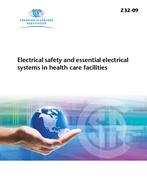Click here to purchase
Preface
This is the third edition of CSA Z32, Electrical safety and essential electrical systems in health care facilities. It supersedes the previous editions, published in 2004 and 1999, and is harmonized with CSA C22.1, Canadian Electrical Code, Part I, and CSA C282, Emergency electrical power supply for buildings.
Scope
1.1 General
1.1.1 Application
This Standard deals with the following subjects:
(a) electrical safety associated with health care provision; and
(b) essential electrical systems for health care facilities.Note: See Clause 3 for the definition of “health care facility”.
1.1.2 Exclusions
1.1.2.1
This Standard is not intended to apply to veterinary facilities, although its electrical safety principles could prove useful in the design, construction, and operation of such facilities.
1.1.2.2
Uninterruptible power supplies, which can be essential for specific critical applications (e.g., critical care equipment and computer equipment), are not covered by this Standard.
1.1.3 Relationship to the Canadian Electrical Code, Part I
Provisions of this Standard are supplementary to the installation requirements specified in Sections 24 and52 of the Canadian Electrical Code, Part I.
1.2 Electrical safety
1.2.1 Areas
This Standard applies to
(a) patient care areas of Class A, Class B, and Class C health care facilities; and
(b) areas outside health care facilities that are intended for patient diagnosis, treatment, or care involving intentional electrical contact of any kind between patients and medical electrical equipment.
1.2.2 Electrical equipment
This Standard applies to
(a) medical electrical equipment;
(b) health-care-facility-owned non-medical electrical equipment;
(c) patient-owned electrical devices; and
(d) the use and management of the equipment and installations in patient care areas.
The electrical equipment described in Items (a) to (c) can be portable or permanently connected.
1.2.3 Aspects of electrical safety
This Standard deals principally with safety from the hazards of electric shock (see Annex A). Other aspects of electrical safety, such as fires and interference with proper operation, are also addressed.
Note: The Canadian Electrical Code, Part I, specifies the minimum requirements for a safe building electrical installation for supplying utilization equipment in patient care areas, but does not specify requirements for the number, arrangement, and circuit loading of branch circuits and receptacles required for the procedures to be performed. Neither does it state requirements for the use and maintenance of such installations. This Standard builds on the requirements of the Canadian Electrical Code, Part I, and provides this additional information.
1.2.4 Medical risks or benefits
The medical purposes, risks, or benefits of procedures or equipment are the professional responsibility of health care practitioners and therefore are beyond the scope of this Standard, which provides general guidelines to ensure the safe use of electrically operated equipment.
1.3 Building electrical installations
This Standard applies to electrical installations in patient care areas of health care facilities.
1.4 Essential electrical systems
Clause 6 applies to the design, installation, operation, and maintenance of the normal and emergency supply required to provide electrical power to those portions of a health care facility’s electrical system in which the interruption of the normal supply can jeopardize effective and safe patient care, the safety of health care facility staff, and public safety. Aspects of emergency electrical power supply systems not covered by Clause 6 are covered by CSA C282.
1.5 Terminology
In CSA standards, “shall” is used to express a requirement, i.e., a provision that the user is obliged to satisfy in order to comply with the standard; “should” is used to express a recommendation or that which is advised but not required; and “may” is used to express an option or that which is permissible within the limits of the standard.Notes accompanying clauses do not include requirements or alternative requirements; the purpose of a note accompanying a clause is to separate from the text explanatory or informative material.Notes to tables and figures are considered part of the table or figure and may be written as requirements. Legends to equations and figures are considered requirements.Annexes are designated normative (mandatory) or informative (non-mandatory) to define their application.
Product Details
- Edition:
- 3rd
- Published:
- 12/01/2009
- ISBN(s):
- 9781554913107
- Number of Pages:
- 86
- File Size:
- 1 file , 2 MB
- Product Code(s):
- 2420335, 2420472, 2420335
